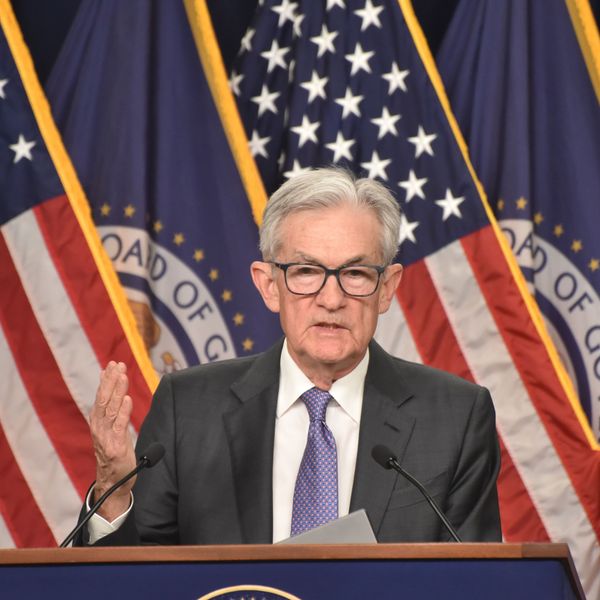
Federal Reserve Chairman Jerome Powell testifies during the Senate Banking, Housing, and Urban Affairs Committee hearing titled The Semiannual Monetary Policy Report to Congress, in Hart Building on Wednesday, June 22, 2022. (Photo: Tom Williams/CQ-Roll Call, Inc via Getty Images)
New Jobs Report Shows Fed Should Halt Harmful Rate Hikes
Wage growth is clearly decelerating, which is enormously consequential for fed policy.
Today's new jobs report in the U.S. shows we added 372,000 jobs in June, bringing the three-month average to 375,000. This is down from the blistering average pace of 561,000 per month for the 12 months ending in February of this year. Job growth remains very strong, but is clearly moderating.
Wage growth is also clearly decelerating, which is enormously consequential for Fed policy. Quarterly wage growth ticked down in June and has dropped substantially in recent months. It is now near its pre-pandemic range.
Make no mistake, we want positive real wage growth for workers. But--and this is hugely important--this decelerating wage growth means the Fed doesn't need more interest rate increases to contain inflation.
Put another way: nominal wage growth moderating even in the face of continued inflation is more evidence that the Fed can keep labor markets tight right now without feeding inflation.
One big concern in the jobs numbers: There is still a giant gap in state and local govt jobs--they are down 656,000 since Feb '20, with close to half of that--306,000 jobs--in education. It's crucial that state and local governments use their ARPA funds to raise pay and refill those jobs.
The private sector has now gained back all of the jobs it lost in the recession. State and local governments have gained back just 55.8%. Folks, we have to push state and local governments to use their ARPA funds to raise pay and hire workers.
Though note, we aren't at "mission accomplished" in the private sector either. Depending on how you measure the counterfactual, the total gap in the labor market right now is around 3 million jobs, with around 2 million of that in the private sector.
The overall numbers mask big disparities for different groups. Due to the impact of structural racism on the labor market, people of color have much higher unemployment rates. For example, the unemployment rate is currently 5.8% for Black workers and 3.3% for white workers.
But all groups are seeing far faster recoveries *than they did following the Great Recession.* From the start of the Great Recession, it took 11.5 years for Black unemployment to get down to 5.8%, but this time around it took 2 years and 4 months.
And that's because, unlike with the Great Recession, Congress did what was needed to spur a robust recovery this time around (namely, CARES and ARPA). We would have millions fewer jobs today if Congress had not enacted the COVID relief and recovery measures it did.
An Urgent Message From Our Co-Founder
Dear Common Dreams reader, The U.S. is on a fast track to authoritarianism like nothing I've ever seen. Meanwhile, corporate news outlets are utterly capitulating to Trump, twisting their coverage to avoid drawing his ire while lining up to stuff cash in his pockets. That's why I believe that Common Dreams is doing the best and most consequential reporting that we've ever done. Our small but mighty team is a progressive reporting powerhouse, covering the news every day that the corporate media never will. Our mission has always been simple: To inform. To inspire. And to ignite change for the common good. Now here's the key piece that I want all our readers to understand: None of this would be possible without your financial support. That's not just some fundraising cliche. It's the absolute and literal truth. We don't accept corporate advertising and never will. We don't have a paywall because we don't think people should be blocked from critical news based on their ability to pay. Everything we do is funded by the donations of readers like you. Will you donate now to help power the nonprofit, independent reporting of Common Dreams? Thank you for being a vital member of our community. Together, we can keep independent journalism alive when it’s needed most. - Craig Brown, Co-founder |
Today's new jobs report in the U.S. shows we added 372,000 jobs in June, bringing the three-month average to 375,000. This is down from the blistering average pace of 561,000 per month for the 12 months ending in February of this year. Job growth remains very strong, but is clearly moderating.
Wage growth is also clearly decelerating, which is enormously consequential for Fed policy. Quarterly wage growth ticked down in June and has dropped substantially in recent months. It is now near its pre-pandemic range.
Make no mistake, we want positive real wage growth for workers. But--and this is hugely important--this decelerating wage growth means the Fed doesn't need more interest rate increases to contain inflation.
Put another way: nominal wage growth moderating even in the face of continued inflation is more evidence that the Fed can keep labor markets tight right now without feeding inflation.
One big concern in the jobs numbers: There is still a giant gap in state and local govt jobs--they are down 656,000 since Feb '20, with close to half of that--306,000 jobs--in education. It's crucial that state and local governments use their ARPA funds to raise pay and refill those jobs.
The private sector has now gained back all of the jobs it lost in the recession. State and local governments have gained back just 55.8%. Folks, we have to push state and local governments to use their ARPA funds to raise pay and hire workers.
Though note, we aren't at "mission accomplished" in the private sector either. Depending on how you measure the counterfactual, the total gap in the labor market right now is around 3 million jobs, with around 2 million of that in the private sector.
The overall numbers mask big disparities for different groups. Due to the impact of structural racism on the labor market, people of color have much higher unemployment rates. For example, the unemployment rate is currently 5.8% for Black workers and 3.3% for white workers.
But all groups are seeing far faster recoveries *than they did following the Great Recession.* From the start of the Great Recession, it took 11.5 years for Black unemployment to get down to 5.8%, but this time around it took 2 years and 4 months.
And that's because, unlike with the Great Recession, Congress did what was needed to spur a robust recovery this time around (namely, CARES and ARPA). We would have millions fewer jobs today if Congress had not enacted the COVID relief and recovery measures it did.
Today's new jobs report in the U.S. shows we added 372,000 jobs in June, bringing the three-month average to 375,000. This is down from the blistering average pace of 561,000 per month for the 12 months ending in February of this year. Job growth remains very strong, but is clearly moderating.
Wage growth is also clearly decelerating, which is enormously consequential for Fed policy. Quarterly wage growth ticked down in June and has dropped substantially in recent months. It is now near its pre-pandemic range.
Make no mistake, we want positive real wage growth for workers. But--and this is hugely important--this decelerating wage growth means the Fed doesn't need more interest rate increases to contain inflation.
Put another way: nominal wage growth moderating even in the face of continued inflation is more evidence that the Fed can keep labor markets tight right now without feeding inflation.
One big concern in the jobs numbers: There is still a giant gap in state and local govt jobs--they are down 656,000 since Feb '20, with close to half of that--306,000 jobs--in education. It's crucial that state and local governments use their ARPA funds to raise pay and refill those jobs.
The private sector has now gained back all of the jobs it lost in the recession. State and local governments have gained back just 55.8%. Folks, we have to push state and local governments to use their ARPA funds to raise pay and hire workers.
Though note, we aren't at "mission accomplished" in the private sector either. Depending on how you measure the counterfactual, the total gap in the labor market right now is around 3 million jobs, with around 2 million of that in the private sector.
The overall numbers mask big disparities for different groups. Due to the impact of structural racism on the labor market, people of color have much higher unemployment rates. For example, the unemployment rate is currently 5.8% for Black workers and 3.3% for white workers.
But all groups are seeing far faster recoveries *than they did following the Great Recession.* From the start of the Great Recession, it took 11.5 years for Black unemployment to get down to 5.8%, but this time around it took 2 years and 4 months.
And that's because, unlike with the Great Recession, Congress did what was needed to spur a robust recovery this time around (namely, CARES and ARPA). We would have millions fewer jobs today if Congress had not enacted the COVID relief and recovery measures it did.

